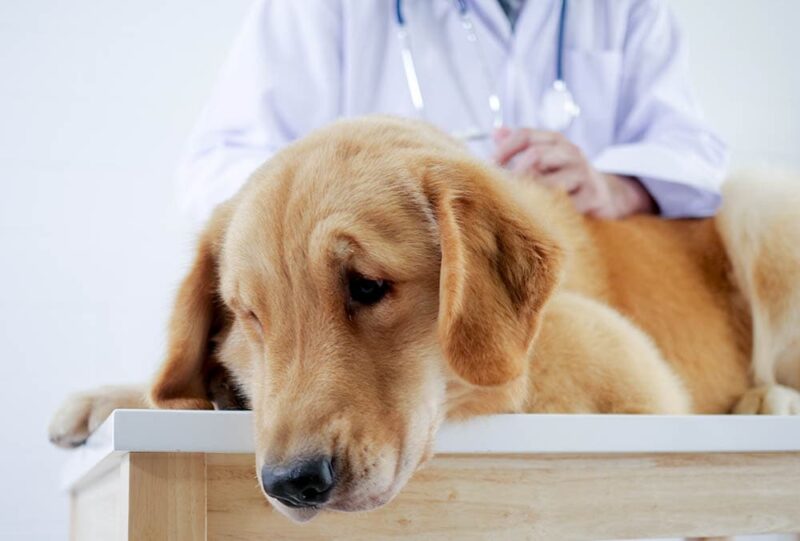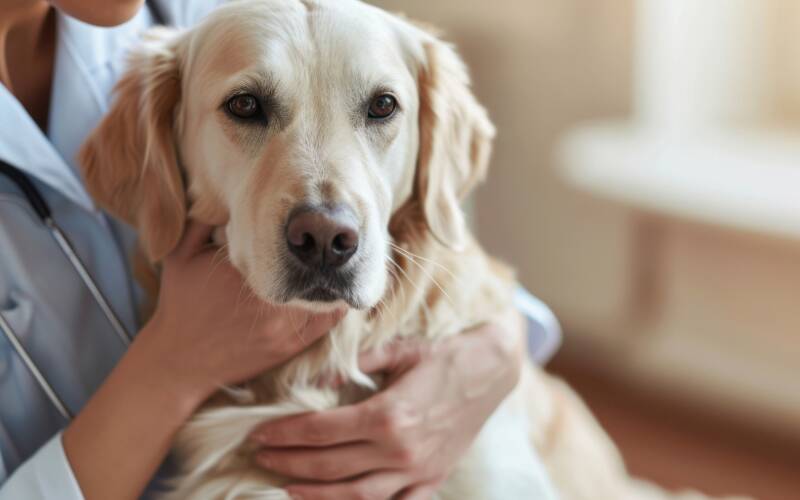The sweet and intelligent Golden Retriever is among many Americans’ most popular pets. But, as many pet parents discovered through painful experiences, they also rank highly on another scale.
Yes, they have a significantly high risk for cancer.
We understand that your pet is a precious part of your life, and you never want to lose them that way. On the brighter side, you can make a difference by pinpointing Golden Retriever cancer symptoms early and avoiding risk factors that cause this deadly disease. That’s what we are going to discuss in this article.
How Common is Cancer in Golden Retrievers?

Canine cancer is a nightmare for every dog lover. If you own a Goldie, this fear is even more pronounced: around 60% of Golden Retrievers develop cancer as they reach the age of 10. This is a whopping rate compared to other breeds, which only have a 25% chance of catching this deadly disease.
Many studies have been conducted regarding this topic, exploring their genes, environment, nutrition, and lifestyle. As scientists and veterinarians have pointed out, genetics play a huge role in making Golden Retrievers more susceptible to various types of cancer. Aside from that, their body size, environmental sensitivity, and nutrition are potential involving factors, too.
Read more >> Golden Retrievers Dying Younger
Types of Cancer in Golden Retrievers and Their Symptoms

This is not to say that your beloved pet is doomed to a painful fate. However, it would help if you took this unsettling statistic as a warning to pay extra attention to Golden Retriever cancer symptoms. Let’s get you familiar with the early signs of the most common cancer types in Golden Retrievers so you can take action before it’s too late:
| Cancer Type | Early Signs |
| Lymphoma | Swollen lymph nodes, lethargy, loss of appetite |
| Hemangiosarcoma | Weakness, pale gums, bloated abdomen |
| Mast Cell Tumors | Skin lumps, itching, vomiting |
| Osteosarcoma | Limping, swelling in legs, reluctance to exercise |
| Melanoma | Dark growths in mouth or on skin, difficulty eating |
These five types of cancer make up 80% of Golden Retriever deaths worldwide. Read on as we help pet parents understand and address each of them.
Lymphoma
Being a systemic malignancy, Lymphoma affects the entire body instead of a specific organ or area. It occurs at lymphocytes – white blood cells that play a key role in the body’s immune system. You may consider these cells the first defense line against bacteria, illnesses, and viruses. Golden Retrievers account for 9.25% of all lymphoma cases, making them the breed with the highest risk of developing lymphoma.
Many dogs show no symptoms of illnesses when diagnosed with lymphoma – that, to us, is the scariest aspect of this cancer. However, you can notice the presence of “lumps” all over their bodies. Veterinarians refer to these lumps as “lymph nodes.” They are usually located beneath the chin, on the shoulders, in the armpits, and behind the knees. Thus, we recommend pet parents pay extra attention to these body parts and take your Goldies to the vet as soon as they notice an unusual lump or bump.
Hemangiosarcoma
While “hemangiosarcomas” sounds like a magic spell, it literally means “blood vessel tumor). It’s another common type of cancer in dogs that affects 5% of cases. Blood vessels are present all over the body, so this tumor can form anywhere. As noted by veterinarians, though, the liver, heart, skin, and spleen are the most affected areas.
Similar to lymphoma, diagnosing hemangiosarcoma is risky. Golden Retrievers often show very vague symptoms that could be mistaken for anemia. According to Dr. Michelle Ritt from the American Kennel Club Canine Health Foundation (CHF), most owners don’t take action until the tumor has ruptured and spread. At this point, it’s too late to save the pet’s life.
“Even when the tumor is quickly detected through regular vet visits, the outlook for dogs with hemangiosarcoma is grim,” she said, “at our clinic, we always advise owners to take preventative measures instead of relying on treatments.”
Mast Cell Tumors
Mast cell tumors are another common cancer in Golden Retrievers. These tumors develop from mast cells, which are involved in allergic reactions and inflammation.
The most obvious sign of a mast cell tumor is usually a lump or bump on or just under the skin. These lumps can change size, sometimes growing larger and then shrinking again. Other symptoms might include itching, vomiting, or loss of appetite.
It’s crucial to have any new lumps checked by your vet, as early detection and removal of mast cell tumors can lead to a much better prognosis.
Read more >> Golden Retriever Skin Problems
Osteosarcoma
Osteosarcoma is a type of bone cancer that, unfortunately, Golden Retrievers are predisposed to. It typically affects the long bones in the legs but can also occur in other bones.
The first sign of osteosarcoma is often limping or favoring one leg. You might notice swelling in the affected limb, and your normally active Golden may become reluctant to exercise or play. As the disease progresses, the pain can cause changes in behavior, such as irritability or loss of appetite.
Early detection is crucial with osteosarcoma, as it can spread quickly to other parts of the body, particularly the lungs.
Melanoma
While we often think of melanoma as a human skin cancer, it can also affect dogs, including Golden Retrievers. In dogs, melanoma most commonly occurs in the mouth or on the skin.
Signs of oral melanoma might include bad breath, difficulty eating or bleeding from the mouth. You might also notice dark growths on your dog’s gums, lips, or tongue. Skin melanomas typically appear as dark, pigmented masses on the skin, often on areas with less fur like the belly or paws.
Regular dental check-ups and thorough physical examinations can help catch melanomas early when they’re most treatable.
General Treatments for Cancer in Golden Retrievers

When it comes to treating cancer in Golden Retrievers, the approach can vary widely depending on the type and stage of cancer. However, there are several common treatment modalities that veterinary oncologists often employ:
- Surgery: For many solid tumors, surgical removal is often the first line of treatment. This can be curative in some cases, especially if the cancer is caught early and hasn’t spread.
- Chemotherapy: Just like in humans, chemotherapy can be used to kill cancer cells throughout the body. The good news is that dogs often tolerate chemotherapy better than humans, experiencing fewer side effects.
- Radiation therapy: This treatment uses high-energy radiation to shrink tumors and kill cancer cells. It’s often used in combination with surgery or chemotherapy.
- Immunotherapy: This newer approach harnesses the power of the dog’s own immune system to fight cancer. It’s showing promising results in certain types of canine cancers.
- Targeted Therapies: These are drugs designed to target specific molecules involved in cancer growth and spread. They can be effective and often have fewer side effects than traditional chemotherapy.
- Palliative care: In cases where a cure isn’t possible, palliative care focuses on improving the quality of life and managing symptoms.
Remember, each case is unique, and your veterinarian will work with you to determine the best treatment plan for your Golden Retriever. They’ll consider factors like the type and stage of cancer, your dog’s overall health, and your family’s wishes and resources.
Golden Retrievers Cancer Preventive Measures
While there’s no surefire way to prevent cancer in Golden Retrievers, there are several steps you can take to reduce the risk and catch any issues early:
- Work with a responsible breeder: Since Golden Retrievers have a pattern of catching cancer, responsible breeders would screen their breeding stocks and work to exclude common cancer in their lineage. A good rule of thumb for welcoming any dog into your life is to verify that the breeder has performed health testing for the breed’s commonly associated conditions.
- Choose the right timing for spaying or neutering: Spaying and neutering can eliminate the risk of developing cancers related to the reproductive organs. However, recent researches point out that performing these procedures before your pup is sexually mature may increase the risk of getting cancer by three to four times. According to veterinarians, the best time to spay/neuter your Goldie is 1-2 years of age.
- Manage your dog’s weight: The best thing you can do to keep your dog healthy and cancer-free as long as possible is to manage their weight. There is a link between obesity and certain malignancies in dogs, such as lipomas.
Healthy lifestyle choices: Interestingly, owners’ lifestyle choices also affect their dogs’ longevity. For example, do you know that dogs also suffer from living in a smoking household? According to Colorado State University research, dogs with long noses like Collies, Dachshunds, and Golden Retrievers are more likely to get nasal cancer when exposed to secondhand smoke. Maintaining a healthy lifestyle is a way to give our Goldies the best possible chances to avoid this deadly disease.
Golden Retriever Cancer Symptoms: The Bottom Line
Facing the reality of cancer in Golden Retrievers can be daunting, but knowledge is your best defense. By understanding the common types of cancer, recognizing early symptoms, and taking preventive measures, you’re giving your furry friend the best chance at a long, healthy life.
Remember, Golden Retrievers are prone to cancer, but that doesn’t mean every Golden will develop the disease. Many live long, cancer-free lives thanks to good genetics, proper care, and a bit of luck.
Stay vigilant, but don’t let fear overshadow the joy of companionship your Golden Retriever brings. Regular vet check-ups, a healthy lifestyle, and lots of love go a long way in keeping your four-legged friend happy and healthy.

As a professional writer who specializes in canine care, I have spent a significant amount of time researching and writing about Golden Retrievers. While I do not own a Golden Retriever, my considerable research and collaboration with doctors, breeders, and Golden Retriever experts has provided me with a lot of information about this incredible breed. My writing covers a wide range of topics, from food and health concerns to behavior and training, to assist owners in raising well-rounded, healthy golden retrievers. Through this website, I wish to share my knowledge and positively touch the lives of both dogs and their humans.
